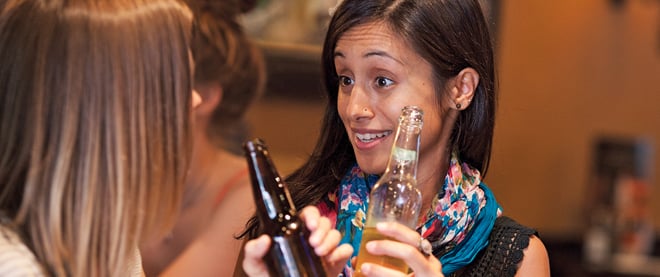The next frontier for beer: women
As British brewers target women, Canadian companies find beer plays a broader role in our culture
Photo: Andrew Tolson
Share

With beer consumption falling for seven straight years and neighbourhood pubs closing at a rate of 29 per week, traditionally suds-soaked Britain is facing a beverage identity crisis while brewers are left scrambling to find new markets for their products. And at least one, Molson Coors Brewing Co., believes it has found the answer: women.
Molson Coors, the company that resulted from the merger of the storied Canadian brewer and Coors Brewing Co. in 2005, is rolling out a new brand in the U.K. and Ireland called Animée, aimed directly at the fairer sex, which currently accounts for just 17 per cent of beer sales there. Described as “lightly sparkling and finely filtered with a delicious fresh taste,” Animée contains four per cent alcohol by volume and comes in three flavours: “clear filtered, crisp rosé and zesty lemon.”
“We are way behind almost every other beer drinking country in the world when it comes to women,” says Kristy McReady, a spokesperson for Molson Coors in Britain, noting that 79 per cent of women in the U.K. say they never, or rarely, drink beer—in part because it’s viewed as being high in calories. “Beer is seen as very masculine, the way it’s marketed and sold. It’s drank from pint glasses and sold in big boxes.”
Molson Coors, which spent two years developing Animée with the input of some 30,000 women, isn’t the only company going down this road. Danish brewer Carlsberg launched Eve in some European markets in 2006, another light, sparkling beer-like beverage flavoured with either lychee, grapefruit or peach and passion fruits. Nor is it the first time brewers have tried to shed beer’s macho image in the hopes of broadening sales. In the early 1990s, Coors introduced a clear, sparkling beverage called Zima that was meant as an alternative to the then-popular category of wine coolers. It was supposed to target men but ended up appealing mostly to women (which essentially killed any chance of anyone with a Y chromosome ever drinking it), and ended up becoming a running joke among late-night talk show hosts like David Letterman because of its “girly man” image. Zima was discontinued in most markets in 2008.
In Canada, the picture is slightly different. There are no plans to roll out Animée here, nor anything like it, since women already account for close to 40 per cent of beer sales, according to Peter Nowlan, Molson Coors Canada’s chief marketing officer. “It’s different here,” Nowlan says. “Beer plays a broader role in Canadian culture.”
At the same time, consumption of beer is holding up rather well in the face of increased competition from wine and other alcoholic beverages. According to the Brewers Association of Canada, the volume of beer sold grew by nearly 17 per cent between 1996 and 2010, roughly at the same rate as the country’s population. Spokesperson André Fortin says the Canadian industry has been successful in offsetting a global decline in beer consumption by developing new products, ranging from craft brews to the current flood of lime-flavoured concoctions. Women provide yet another opportunity. “It’s a huge part of the market that’s available for growth to brewers,” Fortin says. “That’s why you’re starting to see breweries pushing new ways of looking at beer, whether it’s beer pairings or new flavours.”
So while Molson Coors is going after women directly in the U.K., where the situation is more dire, the company has opted for a soft-sell approach in Canada. After conducting an extensive 2009 study that found Canadians increasingly associated beer with specific occasions (a weekend at the cottage, for example), the brewer has dumped the industry’s traditional, demographic-focused marketing campaigns—most of which followed a similar script: young, shaggy-haired guy opens a case of beer, bikini-clad blond models appear from nowhere—in favour of more sexually neutral spots. Hence, a recent Molson Canadian television ad highlights the appeal of a Canadian summer for both men and women, while ads for Molson 67, a light, low-calorie beer, shows an apparently weight-conscious twentysomething male in the bar enjoying a tall 67, while one of his peers is stuck with a tiny glass of shiraz (with the equivalent number of calories).
Nowlan says it’s all part of an effort to position Molson Coors products as more than just high-octane beverages to be guzzled by rowdy guys who watch hockey. He says the company also hopes to capitalize on a growing trend among Canadians—both men and women—toward beer and food pairings, particularly as young urbanites expand their gastronomic horizons beyond wine-focused European cuisines. “I think we’re seeing the start of a beer renaissance,” he says. And thankfully for Canada’s beer purists, it didn’t require any exotic fruit-flavoured malt beverages to get there.